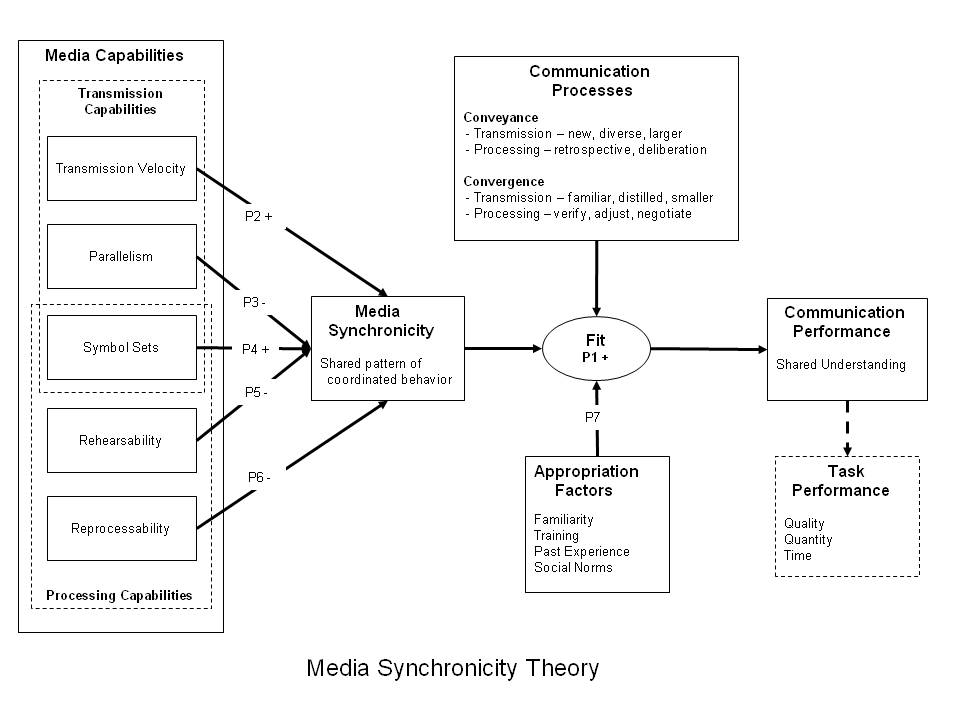Media synchronicity theory

Media Synchronicity Theory
Acronym
MST
Alternate name(s)
N/A
Main dependent construct(s)/factor(s)
Communication performance and effectiveness
Main independent construct(s)/factor(s)
Media synchronicity, transmission velocity, parallelism, symbol sets, rehearsability, reprocessability
Concise description of theory
Media Synchronicity Theory (MST) (Dennis, et al., 2008) looks beyond Daft & Lengel’s media richness to media synchronicity as a predictor of communication performance. Synchronicity is defined as a “state in which individuals are working together at the same time with a common focus.” MST focuses on the capability of media to support synchronicity. It posits that communication will be enhanced when the synchronicity a given medium can support appropriately matches the synchronicity that a communication process requires.
Specifically, MST posits that any communication can be broken into two fundamental processes: conveyance and convergence. The conveyance process is the transmission of new information and the processing of that information by the receiver so he/she can create and/or modify his or her mental model of the situation. The conveyance process is favorably enhanced by media that are intrinsically low in synchronicity. The logic is that conveyance process requires cognitive resources to read, understand and integrate this information into a mental model. Lower synchronicity allows for more time between messages so that the receiver has time to cognitively process the message. The convergence process is the process of mutually agreeing on the meaning of the information (or failing to agree). The convergence process typically requires fewer cognitive resources than conveyance because most of the information has already been conveyed and integrated into the participants’ mental models; the discussion focuses on already processed information and its meaning. Thus convergence is favorably enhanced by media that are intrinsically high in synchronicity because it allows for more “give and take” between the sender and the receiver to arrive at mutual understanding. Moreover, conveyance and convergence processes will be performed at differing levels and intensities depending on how familiar individuals are with the task, the chosen media, and with a communication partner. With a better understanding of the task, the media, and partner, the communication will involve more convergence processes. As a result, higher media synchronicity is more appropriate for the communication. Conversely, with less understanding of the task, the media, and partner, the communication will involve more conveyance processes. As a result, lower media synchronicity is more appropriate for the communication.
The ability of media to support media synchronicity is influenced by five intrinsic capabilities of the media: transmission velocity (how fast a message can reach the recipient), parallelism (the number of transmissions that can take place simultaneously), symbol sets (the different ways a message can be encoded), rehearsability (the ability to fine tune a message before sending it), and reprocessability (the ability to retrieve and process again a received message for better understanding/reference). Media synchronicity is positively associated with transmission velocity, natural symbol sets, and negatively associated with parallelism, rehearsability, and reprocessability. MST posits that there is no best medium in every situation. Communication performance depends on the fit between media synchronicity a given medium can support and the needs for media synchronicity in a given situation. The best choice might not be a single medium, but a combination of methods, and that communication performance will be enhanced by balancing the strengths and weaknesses of media. In addition, as new media technologies appear on the scene and old ones evolve new capabilities and attributes, it may no longer make sense to merely refer to a specific media type, but rather the different sets of capabilities that a given media form may offer to the communicator.
Diagram/schematic of theory
Originating author(s)
Alan R. Dennis, Robert M. Fuller, Joseph S. Valacich
Seminal articles
Daft, R. L., and Lengel, R. H. 1986. “Organizational Information Requirements, Media Richness and Structural Design,” Management Science (32:5), pp. 554-571.
Dennis, A. R., and Valacich, J. S. 1999. “Rethinking Media Richness: Towards a Theory of Media Synchronicity,” in Proceedings of the 32nd Hawaii International Conference on System Sciences, Los Alamitos, CA: IEEE Computer Society Press, Volume 1.
Dennis, Alan R.Fuller, Robert M.Valacich, Joseph S. 2008. "Media, Tasks, And Communication Processes: A Theory Of Media Synchronicity." MIS Quarterly (32:3), pp. 575-600.
Originating area
Media richness theory, information systems
Level of analysis
Group
IS articles that use the theory
Muhren, Willem J.; Van Den Eede, Gerd; Van de Walle, Bartel (2009). Making sense of media synchronicity in humanitarian crises. IEEE Transactions on Professional Communication, 52 (4), 377.
Rai, Arun; Maruping, Likoebe M.; Venkatesh, Viswanath (2009). Offshore information systems project success: The role of social embeddedness and cultural characteristics. MIS Quarterly, 33 (3), 617.
Stone, Dianna L.; Lukaszewski, Kimberly M. (2009). An expanded model of the factors affecting the acceptance and effectiveness of electronic human resource management systems. Human Resource Management Review, 19 (2), 134.
Mohan, Kannan; Kuamr, Nanda; Benbunan-Fich, Raquel (2009). Examining communication media selection and information processing in software development traceability: An empirical investigation. IEEE Transactions on Professional Communication, 52 (1) 17.
Links from this theory to other theories
External links
Original Contributor(s)
Alan Dennis, Robert Fuller, Joe Valacich
Please feel free to make modifications to this site. In order to do so, you must register.
Return to Theories Used in IS Research
